‘The 50 PACT’ Conference: collaborate for better food security in South Asia
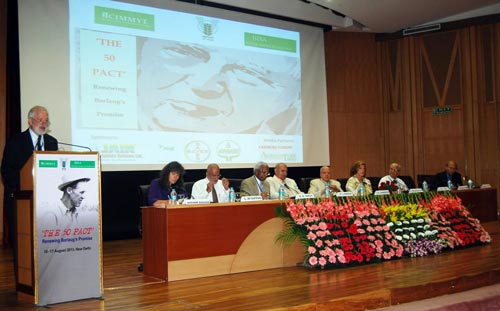 Farmers need to be more involved in developing and refining technology. This was one of the key conclusions of a technology working group comprised of leading Asian scientists, representatives of farmer groups and entrepreneurs who met during “The 50 Pact,” an international conference jointly organized by the Borlaug Institute for South Asia (BISA) and the Indian Council of Agricultural Research (ICAR) to celebrate 50 years of Dr. Norman Borlaug’s first visit to India. Held in New Delhi during 16-17 August, the event brought together more than 200 participants from agriculture institutions, the government, think tanks, industry, and civil society of various countries including Afghanistan, Bangladesh, Belgium, Germany, India, Malaysia, Mexico, Nepal, Sri Lanka, and the United States.
Farmers need to be more involved in developing and refining technology. This was one of the key conclusions of a technology working group comprised of leading Asian scientists, representatives of farmer groups and entrepreneurs who met during “The 50 Pact,” an international conference jointly organized by the Borlaug Institute for South Asia (BISA) and the Indian Council of Agricultural Research (ICAR) to celebrate 50 years of Dr. Norman Borlaug’s first visit to India. Held in New Delhi during 16-17 August, the event brought together more than 200 participants from agriculture institutions, the government, think tanks, industry, and civil society of various countries including Afghanistan, Bangladesh, Belgium, Germany, India, Malaysia, Mexico, Nepal, Sri Lanka, and the United States.
South Asia is the most populous region in the world and several models predict that this region is going to be dramatically impacted by climate change. “We must devise new ways to feed more people with less land, less water and under more difficult climate change conditions,” said Thomas Lumpkin, Director General of CIMMYT, highlighting a significant challenge that requires critical innovations, collaborations and commitments to solve food insecurity and strengthen agriculture in South Asia. This sentiment was echoed by others in the opening session of the conference, including S. Ayyappan, director general of ICAR, government of India, R.S. Paroda, president of Trust for Advancement of Agricultural Sciences (TAAS), R.B. Singh, president of the National Academy of Agricultural Sciences (NAAS), Swapan Datta, ICAR and Marianne Bänzinger of CIMMYT. Remembering their personal interactions with Dr. Borlaug, “the Nobel laureate with a heart for the poor,” and his association with CIMMYT and India, they also felt the need to make a pact to bring about a second green revolution in the South Asia region. M.S. Swaminathan, a legendary figure in Indian agriculture, paid tribute to Dr. Borlaug for his immense contribution in agriculture during the opening ceremony. “From Bengal famine to Right to Food Act of India, it has been a historic transition and Dr. Borlaug played a very important role in this transition through his work in the last 50 years,” Swaminathan said. Jeanie Laube Borlaug, chairperson of BGRI and the daughter of Dr. Norman Borlaug, presented Swaminathan with the Dr. Norman Borlaug Award.
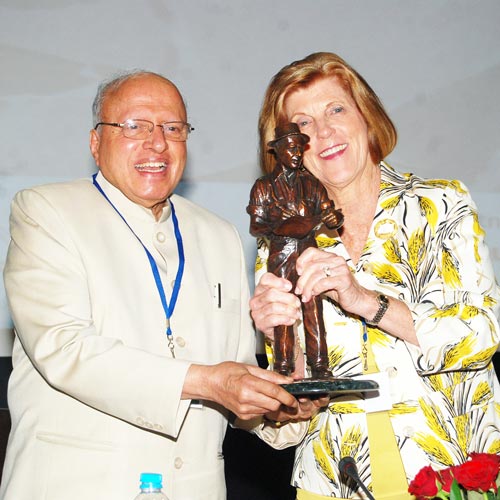 Technology and innovations will play a key role
Technology and innovations will play a key role
Bangladesh, India, Nepal, and Sri Lanka will have to work together to find regional solutions to food insecurity. Representatives from these countries talked about different agricultural developments during the post-green revolution period and emerging challenges and opportunities. They also highlighted how the BISA, with its mandate, furthers research on farming systems in addition to focusing on an eco-regional approach involving other CG centers. Utilizing all technologies, including molecular breeding, biotechnology, precision agronomy, and mobile-based decision making will be crucial. The session on technology highlighted this and also pushed for greater involvement of farmers at every step of new technology development. It is important to capture the process of adoption of innovation by farmers and use new technology to provide feedback to the researchers. The group advocated for increased political will and a better policy environment on the adoption of GM crops. Making agriculture profitable is important for producers and the entire agricultural value chain. Ramesh Chand of ICAR said that his recent analysis in India shows the real farm income is not declining, but the income gap between agricultural and non-agricultural income is widening. Agricultural infrastructure is not well developed, investments are low and land fragmentation is increasing. These are major concerns for this sector. The participants talked about a need for an enhanced cyber infrastructure for crop research, open access to agriculture database, and strengthening the value chain balancing the role of market, price, and technologies.
Greater regional synergy needed
More emphasis on synergy, partnerships, farmer’s welfare, productivity, profitability, and nutrition will be critical to address the problem of hidden hunger and food security in this region. Other areas to focus on include providing access to and the use of cutting edge research and new technologies that are not yet available in the region, ensuring commitments from governments and other donors for investments in agricultural research, advocating for a policy environment that embraces new technologies and invests in agricultural research, building a regional platform of collaboration with partners from all sectors, research centers, governments, the scientific world, and the farming community who share our mandate to transform farmers’ lives in the region.
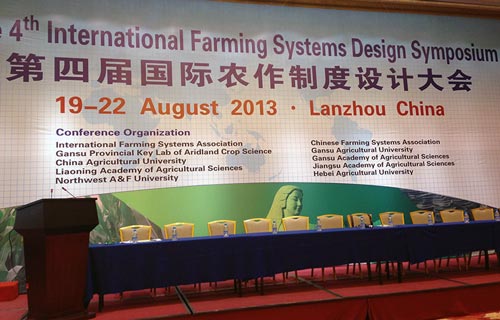 Farming systems all over the world face complex problems in terms of production, such as natural resource depletion, climate change, increasing food demand, and volatile prices. Farmers have to adapt to continuously changing conditions to produce food. ‘Farming systems design’ is an approach that aims at modifying designs of farming systems to sustainably increase the overall productivity and profitability of the systems—and, hopefully, the welfare of individual farming families—while considering interactions in the system. Interactions are important features of farm system structure and operation. They may occur between the various components, including crop-crop, crop-livestock, and farm-household as well as on-farm-off-farm activities as they compete for the same resources.
Farming systems all over the world face complex problems in terms of production, such as natural resource depletion, climate change, increasing food demand, and volatile prices. Farmers have to adapt to continuously changing conditions to produce food. ‘Farming systems design’ is an approach that aims at modifying designs of farming systems to sustainably increase the overall productivity and profitability of the systems—and, hopefully, the welfare of individual farming families—while considering interactions in the system. Interactions are important features of farm system structure and operation. They may occur between the various components, including crop-crop, crop-livestock, and farm-household as well as on-farm-off-farm activities as they compete for the same resources.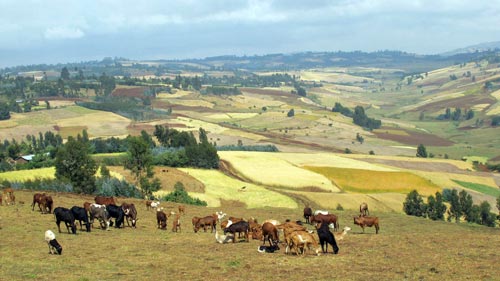 For Peter Carberry, chair of the Program Committee and deputy director at the Commonwealth Scientific and Industrial Research Organization (
For Peter Carberry, chair of the Program Committee and deputy director at the Commonwealth Scientific and Industrial Research Organization (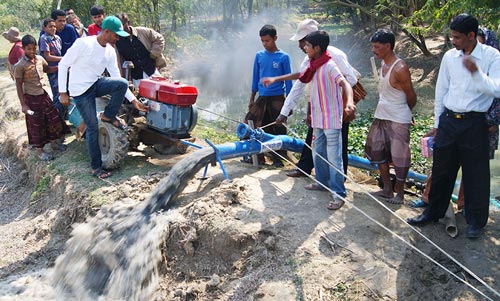
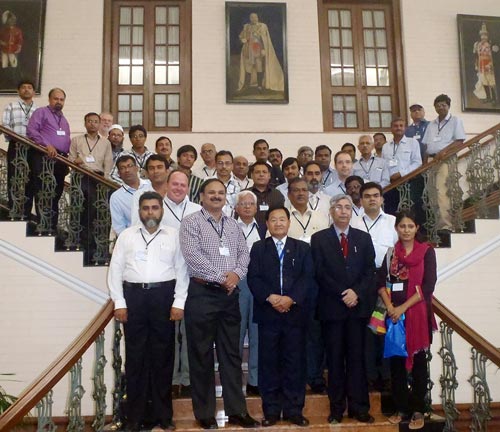 Scientists from the Heat Stress Tolerant Maize for Asia (HTMA) project and representatives from collaborating public and private sector institutions from the region,
Scientists from the Heat Stress Tolerant Maize for Asia (HTMA) project and representatives from collaborating public and private sector institutions from the region, 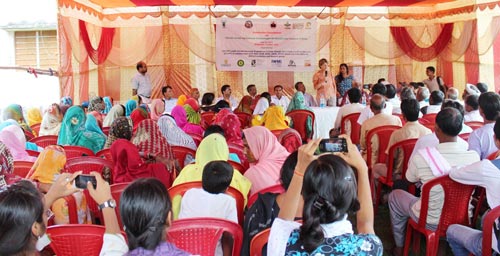 “Climatic extremes and variability are becoming more frequent and resulting in losses for farmers. This issue cannot be addressed in isolation; it needs collective participation of all stakeholders, at all levels,” stated Clare Stirling, leader of the CIMMYT component of the Climate Change, Agriculture and Food Security (CCAFS) CRP, at a stakeholder consultation on ‘Climate Smart Agricultural Technologies for Smallholder Farmers of Bihar’ held on 22 July 2013.
“Climatic extremes and variability are becoming more frequent and resulting in losses for farmers. This issue cannot be addressed in isolation; it needs collective participation of all stakeholders, at all levels,” stated Clare Stirling, leader of the CIMMYT component of the Climate Change, Agriculture and Food Security (CCAFS) CRP, at a stakeholder consultation on ‘Climate Smart Agricultural Technologies for Smallholder Farmers of Bihar’ held on 22 July 2013.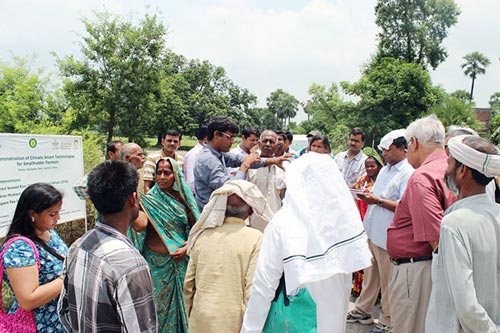 The lively discussions included almost 200 participants, including innovative CSV farmers from Bhatthadasi, Rajapakar, and Mukundpur (Vaishali district); agriculture advisors from various Village Panchayats; climate smart farmer groups, research students, and local service providers. M.L. Jat, CIMMYT-CCAFS South Asia Leader, explained the concept of CCAFS CSVs in South Asia, and the key climate smart activities they are implementing for the benefit of smallholder farmers in Bihar’s Vaishali district. Participants visited demonstration plots where R.K. Jat, CIMMYT-BISA Cropping Systems Agronomist, showed how mechanization and conservation agriculture-based management practices are being implemented even on small, fragmented land holdings. By effectively ‘pooling’ their land for operational purposes, farmers have improved efficiency, reduced costs, and established timely crop management even with uncertain rainfall. R.K. Jat also explained the main advantages of the key climate smart interventions such as zero tillage, Direct Seeded Rice (DSR), raised bed planting, residue management, crop diversification, and nutrient management in managing climate risks and optimizing resources for higher profitability for the smallholders.
The lively discussions included almost 200 participants, including innovative CSV farmers from Bhatthadasi, Rajapakar, and Mukundpur (Vaishali district); agriculture advisors from various Village Panchayats; climate smart farmer groups, research students, and local service providers. M.L. Jat, CIMMYT-CCAFS South Asia Leader, explained the concept of CCAFS CSVs in South Asia, and the key climate smart activities they are implementing for the benefit of smallholder farmers in Bihar’s Vaishali district. Participants visited demonstration plots where R.K. Jat, CIMMYT-BISA Cropping Systems Agronomist, showed how mechanization and conservation agriculture-based management practices are being implemented even on small, fragmented land holdings. By effectively ‘pooling’ their land for operational purposes, farmers have improved efficiency, reduced costs, and established timely crop management even with uncertain rainfall. R.K. Jat also explained the main advantages of the key climate smart interventions such as zero tillage, Direct Seeded Rice (DSR), raised bed planting, residue management, crop diversification, and nutrient management in managing climate risks and optimizing resources for higher profitability for the smallholders.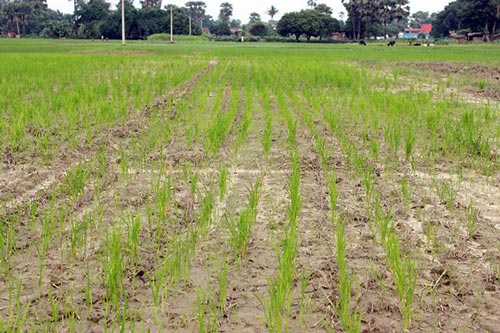 The active participation of about 80 female farmers allowed for a balanced and varied consultation. All the farmers expressed their concerns regarding climate variability and how it is affecting their livelihoods. They shared their experiences of turning their villages into CSVs, and how the new practices have benefitted them; after planting their wheat under zero till in the winter of 2012-13, farmers were initially skeptical of these changes to age-old practices, but having now reaped higher yields with less input costs, all the farmers have committed to planting under zero tillage next season. DSR has also been recently introduced, and the farmers thought the technology seemed promising in that it would reduce cultivation costs and provide some security under the increasing uncertainties of rainfall and labor shortages. The women farmers praised the intoduction of the ZT machine by CIMMYT under CCAFS. With many men migrating to cities, the women highlighted the reduced labor load with the increased availability of machinery and bed planting of maize and legumes.
The active participation of about 80 female farmers allowed for a balanced and varied consultation. All the farmers expressed their concerns regarding climate variability and how it is affecting their livelihoods. They shared their experiences of turning their villages into CSVs, and how the new practices have benefitted them; after planting their wheat under zero till in the winter of 2012-13, farmers were initially skeptical of these changes to age-old practices, but having now reaped higher yields with less input costs, all the farmers have committed to planting under zero tillage next season. DSR has also been recently introduced, and the farmers thought the technology seemed promising in that it would reduce cultivation costs and provide some security under the increasing uncertainties of rainfall and labor shortages. The women farmers praised the intoduction of the ZT machine by CIMMYT under CCAFS. With many men migrating to cities, the women highlighted the reduced labor load with the increased availability of machinery and bed planting of maize and legumes.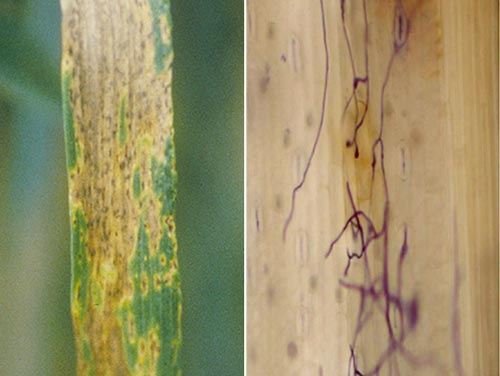 After screening some 500 wheat lines and varieties at 6 sites in Bangladesh, India, and Nepal, a group of scientists were able to identify 35 genotypes that resist spot blotch. This is the number-one disease of wheat in the Eastern Gangetic Plains, seriously damaging the crops of farmers—who are mostly smallholders—on some 9 million hectares.
After screening some 500 wheat lines and varieties at 6 sites in Bangladesh, India, and Nepal, a group of scientists were able to identify 35 genotypes that resist spot blotch. This is the number-one disease of wheat in the Eastern Gangetic Plains, seriously damaging the crops of farmers—who are mostly smallholders—on some 9 million hectares.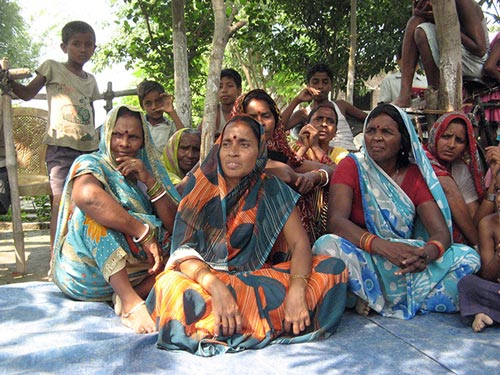 In June 2013, ML Jat (Global Conservation Agriculture Program) and research teams in Bihar and Haryana, India, welcomed CIMMYT gender specialist Tina Beuchelt and gender consultant Cathy Farnworth to discuss integration of gender perspectives into their daily research routine. The visit was triggered by the request from the CRP on Climate Change, Agriculture and Food Security (
In June 2013, ML Jat (Global Conservation Agriculture Program) and research teams in Bihar and Haryana, India, welcomed CIMMYT gender specialist Tina Beuchelt and gender consultant Cathy Farnworth to discuss integration of gender perspectives into their daily research routine. The visit was triggered by the request from the CRP on Climate Change, Agriculture and Food Security (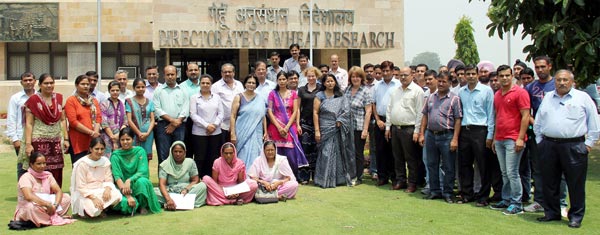 .
. The Nutrient Expert™ decision support tools for maize and wheat in India were officially launched for public use on 20 June 2013 at the National Agricultural Science Centre Complex in New Delhi during a meeting jointly organized by the International Plant Nutrition Institute (
The Nutrient Expert™ decision support tools for maize and wheat in India were officially launched for public use on 20 June 2013 at the National Agricultural Science Centre Complex in New Delhi during a meeting jointly organized by the International Plant Nutrition Institute (
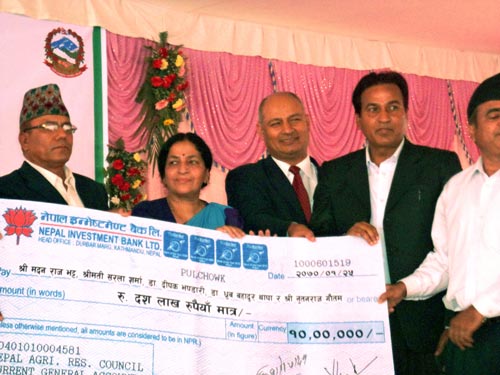 The Government of Nepal and the Nepal Agricultural Research Council (
The Government of Nepal and the Nepal Agricultural Research Council (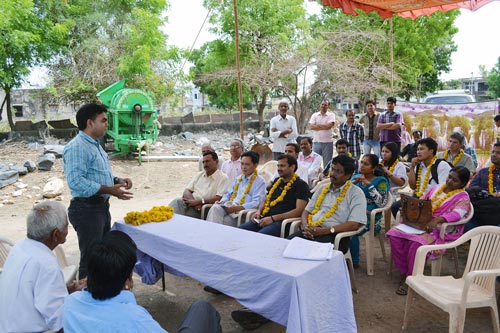 Rajasthan is one of the most stress-prone dry states of India, where farmers grow maize as major crop for food and domestic consumption. As such, it provided a perfect setting for the 2nd Annual Progress Review and Planning Meeting for the Abiotic Stress Tolerant Maize for Asia (ATMA) project. The meeting, jointly organized by the Maharana Pratap University of Agriculture and Technology (
Rajasthan is one of the most stress-prone dry states of India, where farmers grow maize as major crop for food and domestic consumption. As such, it provided a perfect setting for the 2nd Annual Progress Review and Planning Meeting for the Abiotic Stress Tolerant Maize for Asia (ATMA) project. The meeting, jointly organized by the Maharana Pratap University of Agriculture and Technology (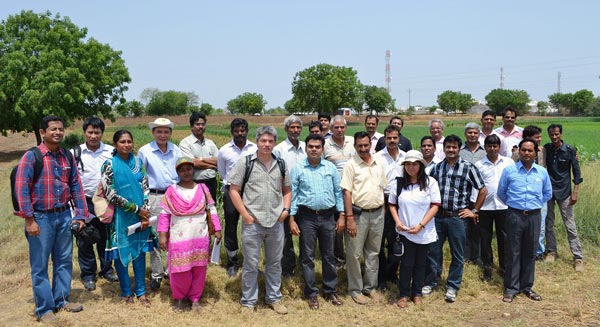 The session’s chairman added: “Our maize farmers have many choices regarding high-yielding varieties and technologies for optimal conditions, and they are experts in achieving high yields under such conditions. But when it comes to stress conditions they have very few choices, and that is where they need our intervention.”
The session’s chairman added: “Our maize farmers have many choices regarding high-yielding varieties and technologies for optimal conditions, and they are experts in achieving high yields under such conditions. But when it comes to stress conditions they have very few choices, and that is where they need our intervention.”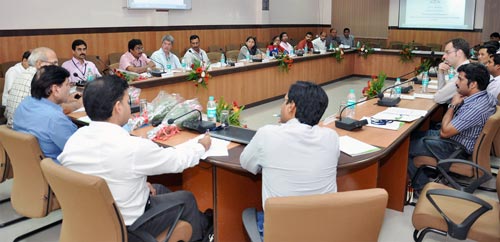 The farmer-scientist interaction produced very useful insights into the issues faced by maize farmers in the region and reiterated the importance of stress tolerant maize varieties for their livelihood. To conclude the day, farmers prepared and shared various maize dishes with the delegation.
The farmer-scientist interaction produced very useful insights into the issues faced by maize farmers in the region and reiterated the importance of stress tolerant maize varieties for their livelihood. To conclude the day, farmers prepared and shared various maize dishes with the delegation.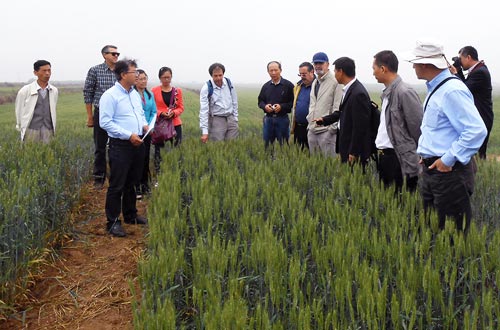 The past few weeks have been busy and interesting in China: preparing for the International Conservation Agriculture Forum in Yinchuan and work travels to Beijing, Yangling (Shaanxi province), and Xuchang (Henan province) are a sure way to keep oneself occupied.
The past few weeks have been busy and interesting in China: preparing for the International Conservation Agriculture Forum in Yinchuan and work travels to Beijing, Yangling (Shaanxi province), and Xuchang (Henan province) are a sure way to keep oneself occupied.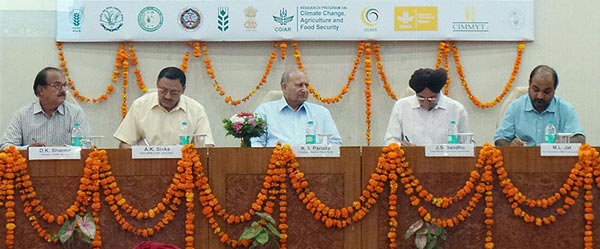
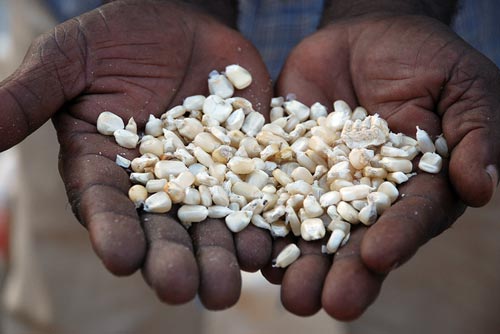 “This project is a rare example of a public-private partnership capable of delivering products to farmers,” said Mike Robinson of the
“This project is a rare example of a public-private partnership capable of delivering products to farmers,” said Mike Robinson of the 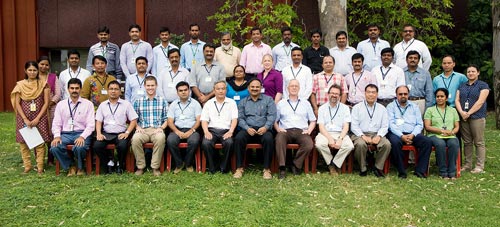
 Spot blotch is one of the major diseases in the wheat growing regions of Nepal and the knowledge allowing researchers to identify and understand the disease is thus crucial. A group of 12 wheat technical research staff from Nepal visited Banaras Hindu University (
Spot blotch is one of the major diseases in the wheat growing regions of Nepal and the knowledge allowing researchers to identify and understand the disease is thus crucial. A group of 12 wheat technical research staff from Nepal visited Banaras Hindu University ( On the second day, participants visited the polyhouse and research station to learn about screening wheat genotypes
On the second day, participants visited the polyhouse and research station to learn about screening wheat genotypes